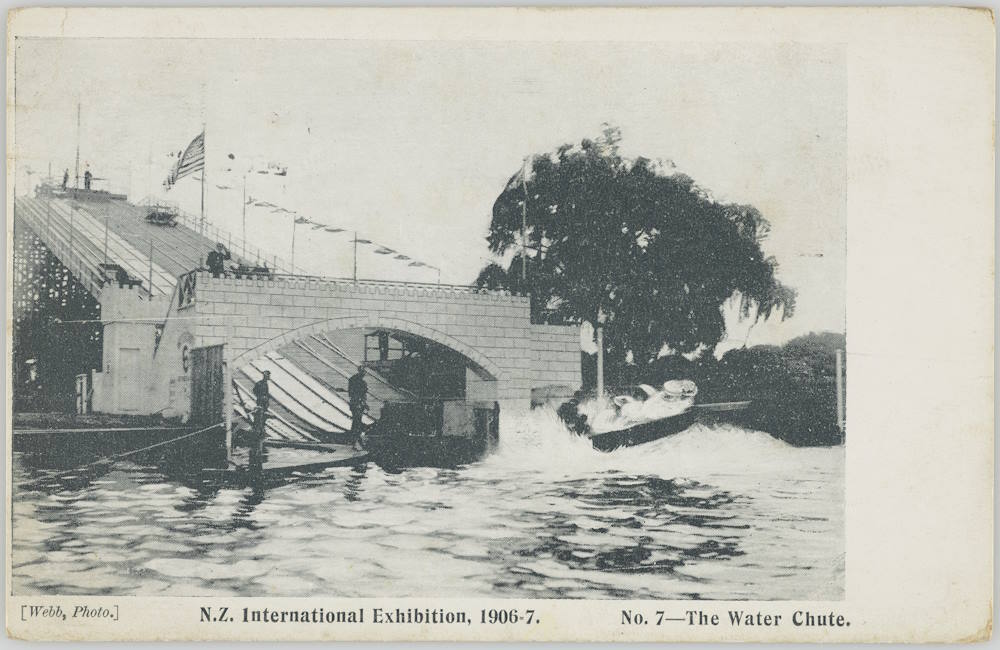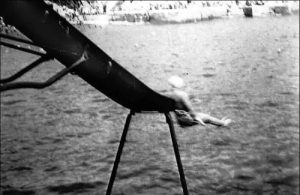
Textbooks are full of information about all kinds of important events – wars, proclamations, innovations and population migrations. But what about equally as important, but perhaps more trivial, historical facts?
For example, what about the history of water slides?
It’s rare to meet someone these days who hasn’t experienced at least one water slide, whether a big one at an amusement park or a smaller inflatable version at a backyard party. And yet, they didn’t exist before the 20th century.
Recently, we tracked down some of the earliest examples of what was to become a centerpiece of amusement park entertainment: the mighty water slide. We found a few early examples of mankind’s commitment to having a good time while traveling at high speeds. Keep in mind that the invention of water slides includes the chutes, fiberglass pool slides and inflatables, so it’s not exactly a linear history.
History of Water Slides: The Wonderland Water Chute
The concept of a water slide can be traced back to ancient times, where people would use natural waterfalls or smooth rocks to slide down into pools of water. However, the modern water slide, as we know it today, was popularized and developed in the 20th century.
One of the first documented water slides came from New Zealand as part of the 1906 International Exhibition. The “Wonderland” area at the exhibition included different types of rides and entertainment experiences – basically a mini amusement park – and among them was a water chute.
Photos from the event show people dressed (or, by today’s standards, overly dressed) as they sat in large wooden “chute boats” that ran down a track and into Victoria Lake, where they skimmed across the surface. Sweet!
Even back then, people knew a cool thing when they saw it (or could slide down it). According to a 1906 newspaper account from a Christchurch, New Zealand newspaper – as quoted on the history site, historygeek.co.nz – the Speaker of the New Zealand House of Representatives Arthur Guinness took one look at the slide and had to give it a try. He rode with a boat full of shrieking girls, according to the newspaper, “with his silk hat pulled over his ears.”
Another rider, according to the site, was Governor General Lord Plunkett, who also commandeered his own cart on the nearby toboggan ride.
After the exhibit and “Wonderland” closed down, the water chute slide was sold to a business who kept it going for a few years in Wellington, New Zealand. But eventually it shut down and was dismantled.
Herbert Sellner Raises the Bar
Herbert Sellner lived in Faribault, Minn. He started his designing career making furniture, then moved on to children’s toys and then, most famously, the Water-Toboggan Slide. Built in 1923, the slide featured a wooden sled that people sat on and rode down an incline into a lake. Much like in New Zealand, this sled did not sink but shot off across the water for distances up to 100 feet, according to the U.S. Patent Services site.
Others took this idea and ran with it, altering the slide and placing various versions at swimming pools, lakes and beaches. The man from Minnesota had invented what would become, over the course of the 20th Century, a staple of the amusement park industry.
He didn’t stop there, either. Sellner went on to invent the Tilt-a-Whirl, which debuted at the Minnesota State Fair in 1927.
Another pioneer in water slide history is Budge Brown, considered the first to invent the fiberglass water slide used in parks. He and wife, Arlene, are inducted in the World Water Park Association Hall of Fame.
 George Millay and Creation of Wet n’ Wild
George Millay and Creation of Wet n’ Wild
Sellner’s invention led to people incorporating the water slide into existing water features such as pools, lakes and, of course, the ocean. But the attraction was so popular that parks started opening that were built around water attractions such as water slides.
George Millay had founded Sea World in 1964 in San Diego and later opened similar parks in Ohio and Orlando, Fla. In the 1970s, he saw the potential for a park built around water attractions, and in 1977 he opened Wet n’ Wild in Orlando, according to Waterpark.com. The park proved so popular that he opened more in the United States, Mexico and Brazil. From the viewpoint of the history of water slides, this was a particularly important step.
While Wet n’ Wild might be the most famous park, others claim to have come first. For example, Cobblestones in Glen Allen, Vir., has been open since the 1950s, according to its website, and has featured a variety of slides. Another early waterpark, Rock-a-Hoola, opened on Interstate 15 between Los Angeles and Las Vegas as a private resort before admitting the general public in 1962. It closed in the late 1980s, then reopened and closed for good in 2004, according to the website, Lost America.
Water parks in general had been so successful that they eventually moved indoors, starting with the first one in Wisconsin Dells at the Polynesian Resort Hotel & Suites in 1994.
No area has taken to waterslides quite like Wisconsin Dells, which is a must-see for the true water slide enthusiast, The area is the “Waterpark Capital of the World,” according the Wisconsin Dells Visitors and Convention Bureau, which goes on to say, “We have the largest concentration of outdoor and indoor water parks of any place on the planet.” There are 50 water slides just in Noah’s Ark water park alone – one of the reasons why it is one of the Top 10 most visited water parks in the world.
21st Century Water Slides
In the more than 100 years since that water chute in Christchurch, the water slide has become a staple of summertime fun around the world. Not only can you visit amusement parks to experience water slides, but now you have the ability to rent your own party inflatable water slide and have fun in your own backyard.
According to the most recent numbers, the most popular water parks are in Florida, starting with Typhoon Lagoon at Walt Disney World, which has more than 2 million visitors annually. Close behind are Blizzard Beach, also at Walt Disney World, and Aquatica and Wet n’ Wild, both in Orlando.
These days, water slides come in a variety of thrilling styles. The tallest, free-fall slide – the 120-foot high Summit Plummet – is at Blizzard Beach. The overall tallest slide is at the Aldeia das Aguas Park Resort in Brazil.
So, the next time you are on a water slide, think about Herbert Sellner alone in his shop, inventing something that would entertain millions. Or those thousands of “Wonderland” visitors on a long-ago weekend in New Zealand, flying down the water chute and trying to keep their silk top hats from flying off.
Both amusement parks – and water slides – have come a long way.


Hi. Need to do your homework. What you have described is what was referred to as a “chute the chutes” water attraction. The first one was built in 1884. Not in the 1920’s. By the 20’s the original type of chute the chutes had become a relic.
My city has a park called Cobblestones which opened as an artificial beach in the 60’s as Overhill Lake… Currently it has three big slides, an intemediate slide, and several kiddie slides, and a water play area… It obviously predates 1977 making it the oldest Waterpark. Not Wet n’ Wild Orlando.
You are also missing Lake Delores/Rock-a-Hoola water park, which opened in 1962 in Newberry Springs, CA between Los Angeles and Las Vegas. I’m fairly certain that pre-dates Wet ‘N Wild by more than a decade. They built a Wet N’ Wild in Vegas to specifically take business away from that place as I recall.
Great Article!
You are compleatly leaving out R.H. “Budge” Brown who made the first fiberglass slide basically creating the slides we have today.
You left out the inventor who first used fiberglass for a pool slide my father Charles R Horn made the first pool slide out of fiberglass in 1956 in North Hollywood California. It was called the aqua slide. He was plastics development because fiberglass is the reinforcing in the plastic.